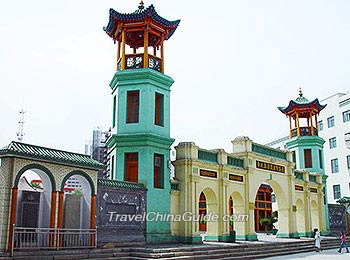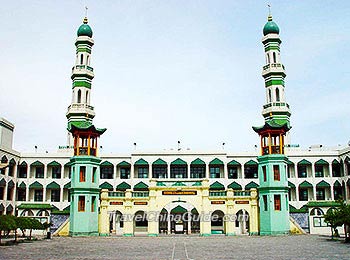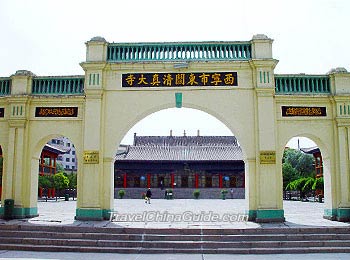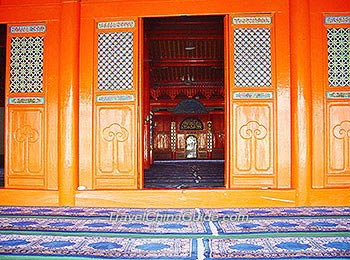Dongguan Mosque & Sun and Moon Mountain
Dongguan Mosque
Situated in Dongguan Street, Xining City, Dongguan Mosque is the biggest mosque in Qinghai Province. It was built in 1380, and now boasts a history of more than 600 years. The Mosque is not only famous for its magnificent architecture but also as a religious education center and as the highest learning institution of Islam.
Covering an area of 11,940 square meters (about 3 acres), Dongguan Mosque is built on a grand scale. Its style combines both Chinese traditional architectural art and Islamic architectural features. When traveling here, the first thing you can see is the elegant arched door on which is written 'Dongguan Mosque'. On either side of the front door stands the Xuanli Lou (Xuanli Pavilion). The Xuanli Lou is special as the place where the Imams invite people to pray. It is 8 meters (some 26 feet) high, and consists of three floors which are hexagonal in shape.
|
|
How to get to Dongguan Mosque
1. Take Sightseeing Bus to Dongguan Qingzhen Dasi (Dongguan Mosque).
2. Take Bus 1, 2, 5, 10, 14, 17, 22, 23, 25, 26, 33, 62, 81, 83, 101, 102, 1002 or 6201 to Bei Xiao Jie Kou and you will see it.
| Entrance Fee | Free |
|---|---|
| Opening Hours | 8:30 - 12:00; 13:00 - 18:00; On Fridays: 15:00 - 18:00 |
Sun and Moon Mountain
Situated 40 kilometers (25 miles) from southwest of Huangyuan County in Xining, Sun and Moon Mountain (Riyue Mountain) marks the boundary between the eastern agricultural area and the western pastoral area of Qinghai Province. From the top of the mountain there is a superb panorama of the beautiful landscape - both prairie and farmland. It is 3,520 meters (11,549 feet) above the sea level and is believed to be the only road to the Qinghai-Tibet Plateau.
Legend about Sun and Moon Mountain
Born with the name of Red Ridge, the Sun and Moon Mountain had been an important thoroughfare to western China for many years and a crucial link between Han and Zang (Tibetan) people. There is a legend concerning it: In the Tang Dynasty (618-907), the emperor gave in marriage his daughter, Princess Wencheng, to the leader of Tibet, Songtsen Gampo to improve the relationship between the two nations. When the princess reached this mountain and took a break, she felt a surge of homesickness. She took out the precious Sun and Moon Mirror given to her by her father because she was told that it would show her hometown while yearning for her home. But she resolutely threw down the mirror so as not to miss her country any more, and continued her journey to the west. The mirror was broken in two pieces shaped like the moon and sun. From then, the mountain got its name, Sun and Moon Mountain.
Daotang River
The Daotang (backflowing) River springs from the west of the Sun and Moon Mountain flowing west to the Qinghai Lake (the largest inland salt lake in China). Again there is a well-known legend concerning the Princess Wencheng. When she passed by the mountain, her tears of homesickness dropped and became the Daotang (Backflowing) River. Its flow westward symbolizes the princess's resolution to never return. In fact, it is the only river flowing from the east to the west in China.
Ri & Yue Pavilions
The Ri (Sun) Pavilion and the Yue (Moon) Pavilion were built on each side of Sun and Moon Mountain pass in memory of Princess Wencheng. Vivid murals are painted to re-create the scene when the princess enters Tibet and her life there. In the twin pavilions, the Yue Pavilion particularly depicts the great pomp of the cultural communication Princess Wencheng brought to Tibet, including crop seeds, technology, medicine, and Buddhism. It was she who brought civilization to Tibet.
Best Time to Visit Sun and Moon Mountain
The period from June to September is the best time to travel there with verdant grasses, wild flowers and tents on the slopes of Sun and Moon Mountain providing the crowning touch to its plateau landscape.
How to get to Sun and Moon Mountain
Take bus from Xining Xinninglu Bus Station to Huangyuan, and then charter a car or taxi to visit the mountain.
| Entrance Fee | CNY 40; CNY 20 for children between 1.2 and 1.4m (3.9 - 4.6 feet); Free for children under 1.2m. |
|---|---|
| Opening Hours | 8:00 - 19:00 |



